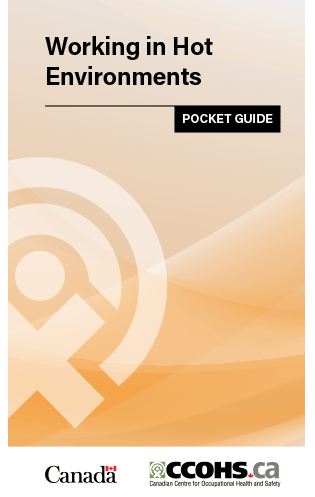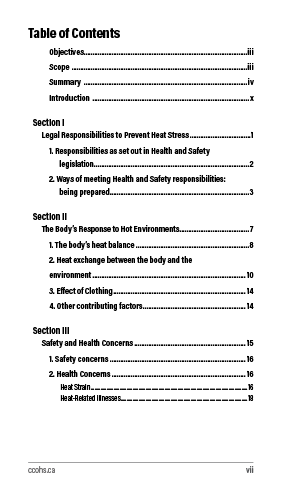Objectives
Scope
Summary
Introduction
Section I
Legal Responsibilities to Prevent Heat Stress
- Responsibilities as set out in Health and Safety Legislation
- Ways of Meeting Health and Safety Responsibilities: Being Prepared
Section II
The Body’s Response to Hot Environments
- The Body’s Heat Balance
- Heat Exchange Between the Body and the Environment
- Effect of Clothing
- Individual Factors
Section III
Safety and Health Concerns
- Safety Concerns
- Health Concerns
- Mental Health
- Climate Change
Section IV
Measures of Heat Exposure
- Measuring Heat Stress Exposure: The Wet-Bulb Globe Temperature Index
- Environmental Measurements of Heat Exposure
- Physiological Monitoring of Heat Exposure
Section V
Heat Exposure Standards and Guidelines
- Occupational Exposure Limits
- Thermal Comfort Guidelines for Offices
Section VI
Control Measures
- Engineering Controls
- Administrative Controls
- Personal Protective Equipment
- Sample Safe Work Practices
Section VII
Occupational Health and Safety Legislation
- Canadian Occupational Health and Safety Legislation
Section VIII
Information Sources
- General Health and Safety Questions
- Canadian Government Departments Responsible for Occupational Health and Safety
- Hot Environments Safety Resources
Section IX
Appendices
- Appendix A - A summary of health hazards and preventive measures
- Appendix B - Safety tips for different levels of the UV index
- Appendix C - Glossary
- Appendix D - Abbreviations
- Appendix E - Sample heat stress policy and checklist
- Appendix F - Case histories: fatalities from occupational heat exposure

